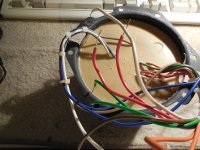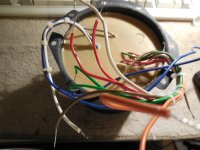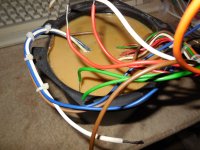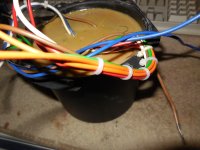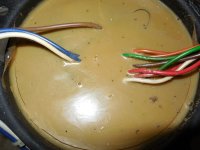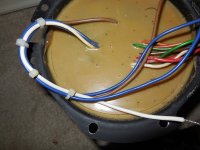I have the transformer pictured. I want to be able to tell which lead is the input and what the outputs are. It is a transformer from a very old rec/amp. The Id on it is :
BANDO
BE71s-0001
ATT 448
Any ideas are welcome and how to determine the leads with an Volt-ohm meter is also an option.
Thanks for any and all "HELP"
BANDO
BE71s-0001
ATT 448
Any ideas are welcome and how to determine the leads with an Volt-ohm meter is also an option.
Thanks for any and all "HELP"
Attachments
Have you mapped out the leads with an ohmmeter, to see which wires are connected to each winding?
If the resistance between wire1 and wire2 is more than 50K ohms, they are definitely NOT connected to the same winding.
If the resistance between wire1 and wire2 is less than 500 ohms, they definitely ARE connected to the same winding.
If the resistance is more than 500 ohms and less than 50Kohms, you need somebody with serious expertise. Or else your transformer is blown. Or both/
If the resistance between wire1 and wire2 is more than 50K ohms, they are definitely NOT connected to the same winding.
If the resistance between wire1 and wire2 is less than 500 ohms, they definitely ARE connected to the same winding.
If the resistance is more than 500 ohms and less than 50Kohms, you need somebody with serious expertise. Or else your transformer is blown. Or both/
Last edited:
Have you mapped out the leads with an ohmmeter, to see which wires are connected to each winding?
If the resistance between wire1 and wire2 is more than 50K ohms, they are definitely NOT connected to the same winding.
If the resistance between wire1 and wire2 is less than 500 ohms, they definitely ARE connected to the same winding.
If the resistance is more than 500 ohms and less than 50Kohms, you need somebody with serious expertise. Or else your transformer is blown. Or both/
Thank you ever so much. This is just the information I needed to get started. Thanks again.
Okay Mark
I think the Blue leads are not the input power leads. The resistance is greater than 50K to all others, but just 1.6 ohms.
The white brown on that side have 3.6 ohms, but < 50K to all other leads. So I think that the higher resistance says they are the input leads...
Green Pair 3.1 ohms and < 50 K except the brown
Orange Pair 7.1 ohms and < 50 K except the brown
Red Pair 1.2 ohms and < 50 K except the white
The white brown on that side reads < 50 K ohms
The Red Pair has 1.3 ohms to the white on that side
The Orange and Green have 3.3 ohms and 5.3 ohms switched around in relationship to each other.
and both leads of the green are 2.2 to the brown and
the both of the orange are 4.2 to the brown.
So I think that the red has a white lead center tap by itself...
and the orange green are centered on the brown.
Can conclude that the lower the ohms the LESS the number of windings and therefore the Lower the voltage?
This is beginning to sound like a word puzzle...
Thanks for your reply again...
I think the Blue leads are not the input power leads. The resistance is greater than 50K to all others, but just 1.6 ohms.
The white brown on that side have 3.6 ohms, but < 50K to all other leads. So I think that the higher resistance says they are the input leads...
Green Pair 3.1 ohms and < 50 K except the brown
Orange Pair 7.1 ohms and < 50 K except the brown
Red Pair 1.2 ohms and < 50 K except the white
The white brown on that side reads < 50 K ohms
The Red Pair has 1.3 ohms to the white on that side
The Orange and Green have 3.3 ohms and 5.3 ohms switched around in relationship to each other.
and both leads of the green are 2.2 to the brown and
the both of the orange are 4.2 to the brown.
So I think that the red has a white lead center tap by itself...
and the orange green are centered on the brown.
Can conclude that the lower the ohms the LESS the number of windings and therefore the Lower the voltage?
This is beginning to sound like a word puzzle...
Thanks for your reply again...
Last edited:
You have turned this into a word puzzle....................I think the Blue leads are not the input power leads. The resistance is greater than 50K to all others, but just 1.6 ohms.
The white brown on that side have 3.6 ohms, but < 50K to all other leads. So I think that the higher resistance says they are the input leads...
Green Pair 3.1 ohms and < 50 K except the brown
Orange Pair 7.1 ohms and < 50 K except the brown
Red Pair 1.2 ohms and < 50 K except the white
The white brown on that side reads < 50 K ohms
The Red Pair has 1.3 ohms to the white on that side
The Orange and Green have 3.3 ohms and 5.3 ohms switched around in relationship to each other.
and both leads of the green are 2.2 to the brown and
the both of the orange are 4.2 to the brown.
So I think that the red has a white lead center tap by itself...
and the orange green are centered on the brown.
Can conclude that the lower the ohms the LESS the number of windings and therefore the Lower the voltage?
This is beginning to sound like a word puzzle...
................
You NEED to identify which wires are connected internally.
Be methodical.
That will then allow you to identify which "winding" is isolated from all others.
That's important. which are "isolated" from all others.
Is this telling you that orange & green & brown are all connected?The Orange and Green have 3.3 ohms and 5.3 ohms switched around in relationship to each other.
and both leads of the green are 2.2 to the brown and
the both of the orange are 4.2 to the brown.
Is this telling you that red and white and brown are all connected?Red Pair 1.2 ohms and < 50 K except the white
The white brown on that side reads < 50 K ohms
The Red Pair has 1.3 ohms to the white on that side
Last edited:
- Status
- This old topic is closed. If you want to reopen this topic, contact a moderator using the "Report Post" button.
